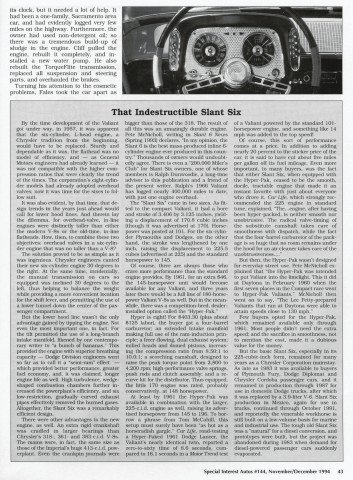
It’s a face only the hardest of the hard core can love…and even then, it’s not easy. The “Road Toad.” A bastard child of of the graceful, sweeping Forward Look ideal of the late 50s, the 1960 Valiant was a visual rebellion of sorts. It represents the “angry drunk with a crayon and napkin” school of automotive styling, like no other machine of the era.
Awkward and ungainly from nearly every angle, yes…but beauty is more than skin deep, and beneath that skin is the basic foundation of the entire classic Mopar era. The 1960 Valiant is the Genesis car, the one that every single A, B and E-Body ever built owes it’s basic DNA.
The very first A-Body was not even an A-Body in the very beginning. That designation came later, when the little bugger’s genes were split to create the controversial full size line of 1962…but, we’re getting ahead of ourselves.
In the beginning, it was known as project Falcon, (a name later snatched by Ford) and the mission was to create viable competition for the increasingly popular European imports that had begun washing up on our shores as a product of the post war reconstruction industrial and trade boom.

By late 1957, the project was in full “go” mode. It had to be small, it had to be light and nimble. It had to be cheap to produce, purchase and maintain. Just as importantly, it had to be reliable like an anvil.
Tasked with this were a team of the most brilliant and creative minds the world of automotive engineering had ever known, and what they conjured and manifested in the form of the 1960 Valiant formed the backbone of everything Mopar we know today.
Unibody construction was a concept Chrysler had perfected earlier with the Airflow cars of the 1930s, but it wasn’t until the Valiant that the idea really made sense.
How versatile and flexible was this platform? Strip away the sheetmetal from a ’60 Valiant and a ’71 Hemi ‘Cuda and you will see the exact same structures and component relationships. Different in scale, but identical in execution.
Hard to improve on perfection. The frame rails, leaf springs, front suspension, torsion bars and drive trains remained essentially unchanged for the entire 16 year run of the original Mopar Compact line. Many of these are still pulling daily driver duty all over the world, and likely will for generations to come!

The Valiant wasn’t even a Plymouth at the very beginning. It was just Valiant, and happened to be sold through Plymouth dealers. It was such a hot seller that Dodge dealers wanted a piece of the action, so for ’61, a few cosmetic tweaks were made, and the Dodge Lancer was born. The Valiant then became a Plymouth by default.
So, the solid little compact line should have evolved and morphed on its own and remained isolated to its intended niche…and that’s exactly what would have happened if not for a bad bit of intelligence passed along by an incompetent corporate spy.
Right about the time of the Valiant’s first public appearance, word got to Chrysler product planners that Chevrolet was planning on drastically reducing the size of its signature car. The suits were in a sudden panic. The full size Dodge and Plymouth lines were scheduled to actually be slightly upsized for 1962..the exact opposite direction of the industry leader. Not good!
Well, the truth was, Chevy was planning on an all new car to fit between the full size line and the compact Chevy Nova and Corvair models.
Never the less, the bad info led to some drastic action. In a perceived bind, and always in a pinch, Chrysler decided to take the Valiant/Lancer structure, and increase its size in every dimension. OK, that part was good.
The bad part is that all of the styling for the full size ’62s had been completed and the budget run dry. So, to make the new car fit the smaller platform, they essentially took a Sawzall to the clay models and chopped away until everything fit…kinda, sorta…and thus, the B-Body was born.
The final link in the chain came in 1970 when the basic platform was widened a bit and chopped at the tail to give birth to the “Pony Car” E-Bodies.
But, back to the Genesis machine. Hard to look at then, and more than a half century later, still unique enough to make even the most loyal Moparist wince and squint his eyes in search of a pleasing aesthetic that just never materializes.
You don’t really find the beauty of these things until you climb inside and crank one over.
The earliest A, with the most basic standard equipment (as it’s designers intended), a 170 Slant, floor mounted 3-speed stick shift and 3:55 gears on 13-inch rubber is pure automotive happy. Friendly and nimble beyond description. The free revving short stroke Slant sings and grunts in all the right ways. At 2700 pounds, it runs, feels and sounds like a vintage European sporty car.
Unfortunately, in a culture centered around big horsepower and crazy numbers, the subtle, smooth, friendly nature of these cars is completely overlooked by most.
To drive a “Road Toad” is to love a Road Toad…you just don’t want to look back at it after you’ve shut the door and began to walk away.

















Would love to see Tony run a magazine similar to the amazing Cars Illustrated of the mid-eighties once again. I still own every single copy of those incredible magazines. Great , fun , street-wise articles that made us young (then) guys want to wrench on cars (all kinds), and “run ‘em” like they were intended to be run. Good times. Thanks Tony.
Tony’s dedicated himself to his “Uncle Tony’s Garage” video channel on YouTube where you can get near-daily updates.